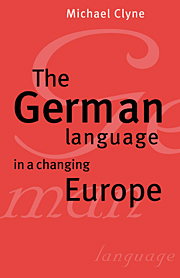Book contents
- Frontmatter
- Contents
- List of maps
- List of tables
- Acknowledgements
- Places mentioned in the text
- German, Dutch and Frisian dialects
- Introduction
- 1 The status of German in contemporary Europe
- 2 German as a pluricentric language
- 3 German in divided and unified Germany
- 4 Language and regionalism in Germany and Austria
- 5 Communication patterns
- 6 Gender, generation and politics – variation and change in language and discourse
- 7 Communication norms and communication barriers
- 8 Recent Anglo-American influence
- Closing remarks
- Glossary of linguistic terms used
- Bibliography
- Subject index
- Index of names
1 - The status of German in contemporary Europe
Published online by Cambridge University Press: 21 January 2010
- Frontmatter
- Contents
- List of maps
- List of tables
- Acknowledgements
- Places mentioned in the text
- German, Dutch and Frisian dialects
- Introduction
- 1 The status of German in contemporary Europe
- 2 German as a pluricentric language
- 3 German in divided and unified Germany
- 4 Language and regionalism in Germany and Austria
- 5 Communication patterns
- 6 Gender, generation and politics – variation and change in language and discourse
- 7 Communication norms and communication barriers
- 8 Recent Anglo-American influence
- Closing remarks
- Glossary of linguistic terms used
- Bibliography
- Subject index
- Index of names
Summary
The contemporary language situation in Europe
The language situation in Europe today is driven by two seemingly contradictory tendencies – tendencies towards what Fishman (1971) terms ‘massification’ and ‘diversification’ – which are operating simultaneously. Examples of massification are open economic borders between member countries of the European Union (then European Community) as from January 1993 and the enlargement of the Union to include Austria, Sweden, Norway, and Finland in 1995, and the development of an expanded European Economic Region progressively to include former Soviet Bloc countries, all of which could have homogenizing effects on language and culture. On the other hand, diversification is exemplified in the resurgence of regions in Western Europe and the re-emergence of smaller, largely language-based, nation-states in Central and Eastern Europe to replace the multinational empire of the USSR and the multinational political entities of Yugoslavia and Czechoslovakia. The language-based nature of these nation-states brings to the fore longstanding ethnolinguistic tensions and disputes over minority rights which may result in new post-Communist nations of Central and Eastern Europe splitting up into more and more separate entities.
But alongside this diversification, we see the opening up of nations and groups which have been closed to half of Europe and much of the rest of the world for over forty years. This has brought the challenges of communicating with other peoples in a range of contexts.
Another aspect of diversification is the legal strengthening of regional and ethnic minority languages through the passing of the Charter of Regional and Minority Languages by the Council of Europe member states in 1993.
- Type
- Chapter
- Information
- The German Language in a Changing Europe , pp. 3 - 19Publisher: Cambridge University PressPrint publication year: 1995



